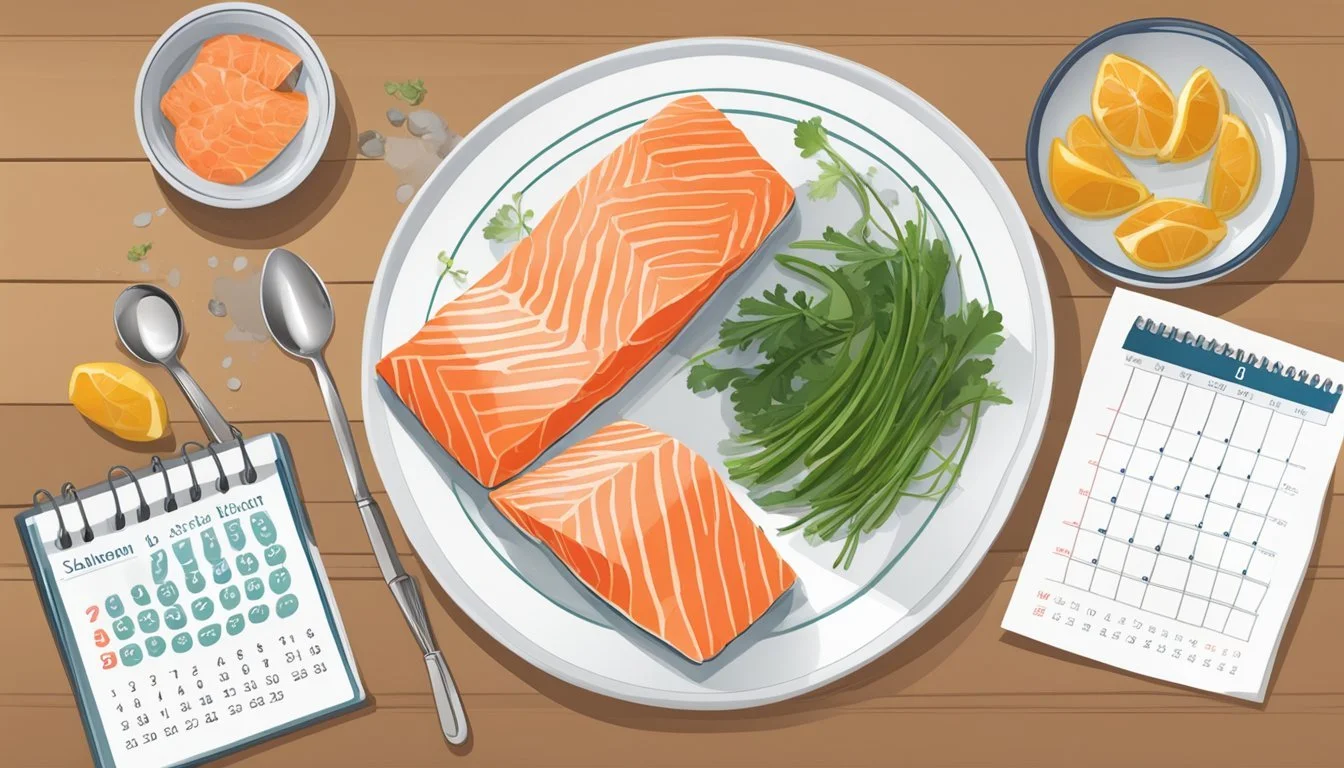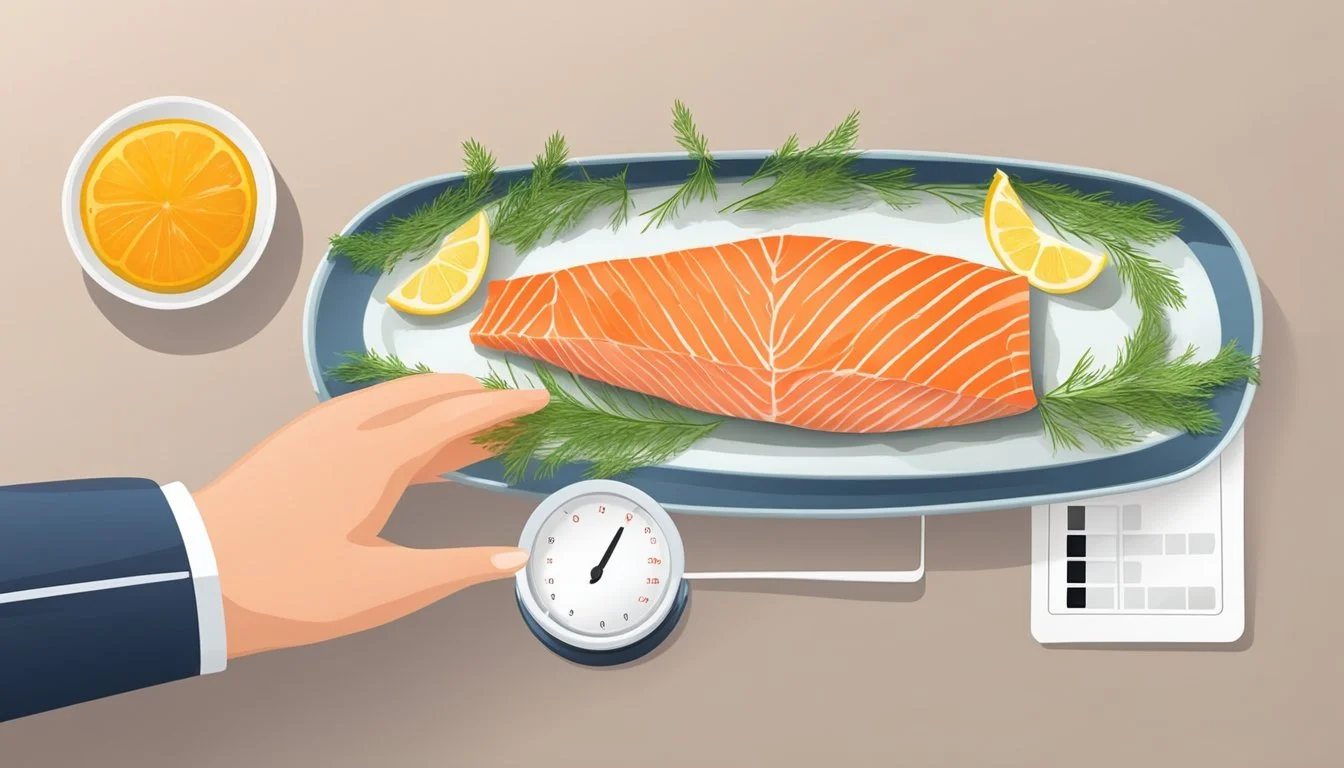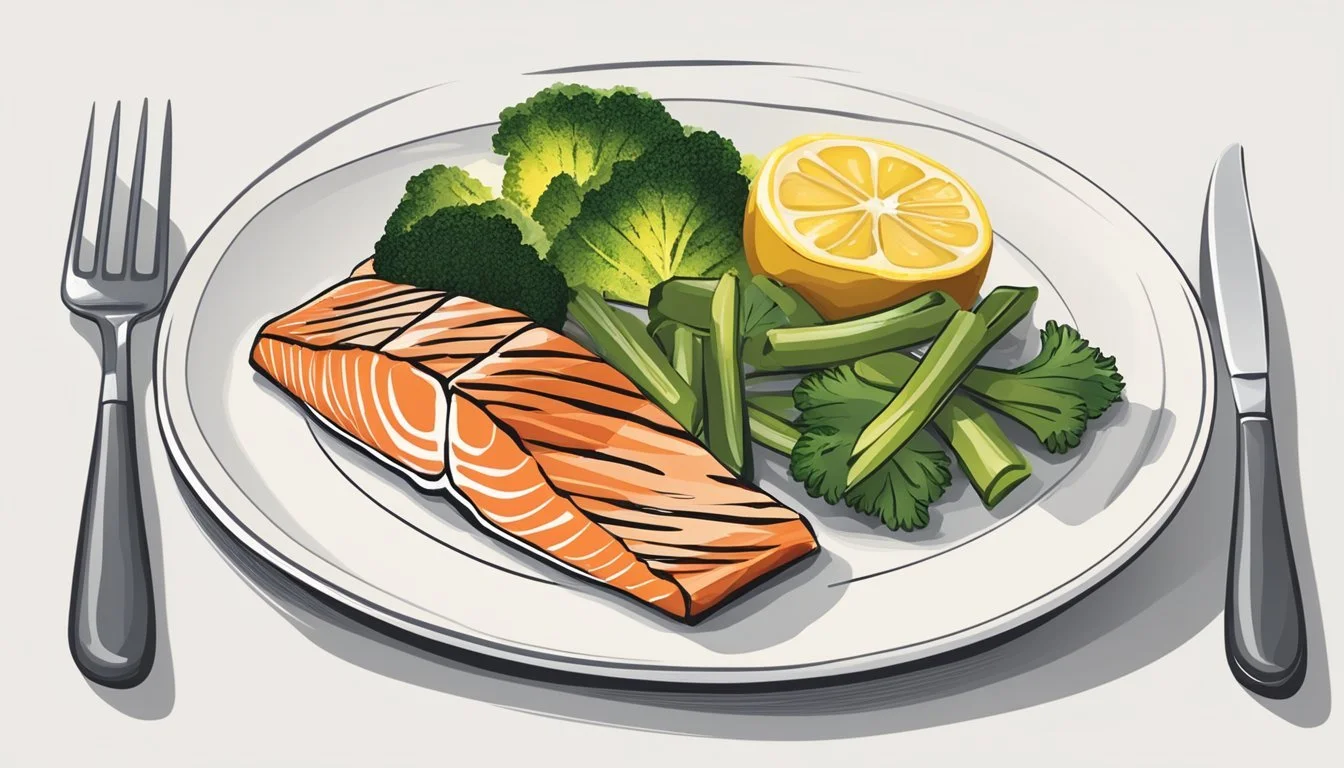How Many Ounces of Salmon Per Week for Optimal Health Benefits
Salmon (What wine goes well with salmon?) is a widely enjoyed fish known for its rich flavor and numerous health benefits. It is a prime source of protein, rich in omega-3 fatty acids, and provides an abundance of vitamins, most notably a range of B vitamins. Health authorities have weighed in on its consumption, offering guidelines for optimal intake. The United States Food and Drug Administration (FDA) suggests that most adults can safely consume up to 12 ounces of salmon per week. This amount balances the benefits of its nutrient content with the potential risks associated with contaminants found in fish.
For children, the recommended serving sizes are smaller and adjusted according to age. Children from the age of 11 are advised to follow the adult guidelines of two four-ounce servings of salmon per week, ensuring they receive the nutritional benefits without overexposure to potential contaminants. Younger children, depending on their age group, should have even smaller portion sizes, ranging from 1 ounce to 3 ounces, served twice a week. It is important for dietary routines to include a variety of protein sources, and salmon can be a substantial part of this variety.
Regular consumption of salmon, within the advised limits, can play an important role in a balanced diet. The guidelines help consumers enjoy the health benefits of this fatty fish while minimizing the risks, making it a smart choice for those who are health-conscious. When incorporated properly into one's diet, salmon can support cardiovascular health, aid in cognitive function, and contribute to overall well-being.
Optimal Salmon Intake
When considering the ideal amount of salmon to include in one's diet, health experts often emphasize the importance of balance. Salmon is a nutrient-dense fish, high in omega-3 fatty acids and protein, yet low in saturated fat. For most adults, the recommendation is to aim for eight to 12 ounces of salmon per week. This recommendation is based on obtaining the benefits of omega-3 fatty acids, which are crucial for heart and brain health.
The breakdown of weekly salmon intake could look as follows:
Adults: 2-3 servings per week
Serving Size: Approximately 3-4 ounces per serving
Age Group Serving Size Frequency Children 1-3 1 oz Twice a week Children 4-7 2 oz Twice a week Children 8-10 3 oz Twice a week Adults 3-4 oz Two to three times a week
It's important to note that individuals with specific health concerns should consult with healthcare professionals to tailor their consumption to meet personal health needs. Incorporating salmon into an adult's diet offers a substantial amount of protein, averaging 22-25 grams per 3.5-ounce serving, supporting muscle maintenance and growth while contributing to overall dietary requirements.
Consciously integrating salmon into meals ensures a diet replete in essential nutrients without the risk of toxicity, particularly considering concerns over mercury and other contaminants in some fish species. The goal is to reap the benefits of salmon while respecting the body's limits and needs.
Nutritional Benefits of Salmon
Salmon is recognized for its exceptional nutritional profile, which includes high-quality protein, vital vitamins and minerals, and a renowned concentration of omega-3 fatty acids. This fish is not only a nutrient-dense food that supports overall health but also plays a specific role in heart health and cognitive function.
Macronutrients and Calories
Salmon is an excellent source of protein, providing about 22-25 grams per 3.5-ounce serving. Regarding calories, a 3.5-ounce serving of farmed Atlantic salmon contains approximately 206 calories, while wild-caught salmon can vary slightly in caloric content.
Vitamins and Minerals
This nutritious fish comes packed with a range of B vitamins which are crucial for energy production and brain health. A typical serving size contains the following B vitamins:
B3 (Niacin): 8.5 mg, or 53% of the DV
B6 (Pyridoxine): 0.6 mg, or 35% of the DV
B9 (Folate): 29 mcg, or 7% of the DV
B12 (Cobalamin): 3 mcg, or 125% of the DV
Salmon is also a source of the following minerals:
Vitamin D: Vital for bone health and calcium absorption
Iron: Necessary for blood cell production
Potassium: Helps to control blood pressure
Selenium: A powerful antioxidant
Iodine: Essential for thyroid function
Zinc and Phosphorus: Important for body repair and maintenance
Omega-3 Fatty Acids and Health
Omega-3 fatty acids in salmon—eicosapentaenoic acid (EPA) and docosahexaenoic acid (DHA)—are essential fats that the body can’t produce on its own. These fats are known to reduce inflammation, lower blood pressure, and significantly decrease the risk of chronic diseases such as heart disease, cancer, and diabetes.
Additional Nutrients
Salmon offers other beneficial compounds such as:
Astaxanthin: An antioxidant that helps with skin health and may fight inflammation.
Choline: Important for liver function, muscle movement, and supporting a healthy nervous system.
Health Benefits by Consumption
Consuming salmon on a regular basis can bring multiple health benefits:
Heart Health: Reduces the risk of cardiovascular disease, heart attacks, and strokes.
Brain Health: Promotes cognitive development and may aid in the prevention of dementia.
Weight Loss: Its high protein content can help with satiety and weight management.
Considerations for Specific Groups
Different groups such as children, pregnant women, and breastfeeding mothers may benefit particularly from the high nutritional value of salmon. It supports brain development in children and the iodine content is a critical nutrient for both the mother and the developing fetus. However, it's important for these groups to consume salmon that's low in mercury.
For individuals with conditions like diabetes or those managing weight loss, salmon's lean protein and healthy fat profile make it a suitable dietary component. The nutrients found in salmon may help regulate blood sugar and contribute to a feeling of fullness, thus aiding in weight management.
Safety and Risks Associated with Salmon
When considering the consumption of salmon, it is important to be aware of potential contaminants such as mercury and the differences between farmed and wild salmon, as well as recommended serving sizes to balance nutritional benefits with these safety concerns.
Mercury and Contaminants
Salmon is generally low in mercury compared to other fish, but it can accumulate both mercury and other contaminants such as polychlorinated biphenyls (PCBs) from their environment. The FDA monitors mercury levels in seafood and provides guidelines to minimize risk, especially for vulnerable groups like pregnant women and children. Eating a variety of seafood is recommended to limit exposure to these contaminants.
Average Mercury level in Salmon: Low
Main contaminants of concern: Mercury, PCBs
High-risk groups: Pregnant women, children
Farmed vs. Wild Salmon
There is a debate on the nutritional differences between farmed and wild-caught salmon. Wild salmon tend to have a more varied diet and therefore can have a different nutritional profile, including higher levels of omega-3 fatty acids and potentially lower contaminant levels. In contrast, farmed salmon's diet is controlled, which can affect their nutritional content. Both farmed and wild salmon are considered safe to eat when sourced responsibly.
Omega-3 levels: Higher in wild salmon
Contaminant levels: Potentially lower in wild salmon
Serving Recommendations
The USDA and public health officials typically recommend that adults consume eight to 12 ounces of salmon or other "best choices" seafood per week. This serving size takes into account the need for omega-3 fatty acids and balances it against potential risks from contaminants. For most adults, up to 12 ounces per week is safe, which equates to two to three servings.
Adults: Up to 12 ounces per week
Number of servings: Two to three 4-ounce servings per week
Integrating Salmon in Your Diet
Integrating salmon into one's weekly diet can enhance nutritional intake, notably through its high protein content and beneficial omega-3 fatty acids. Appropriate preparation and consumption align with various health-oriented dietary patterns and can contribute to weight management.
Cooking and Preparation
When cooking salmon, one may choose to leave the skin on to maintain moisture during the cooking process. For added flavor, a glaze such as maple or teriyaki can be applied. Salmon can be prepared in various ways, including baking, grilling, or pan-searing. Adults are generally advised to consume up to 12 ounces of a variety of seafood per week, with emphasis on fatty fish such as salmon for optimal health benefits.
Baked Salmon (What wine goes well with grilled salmon?): 12-15 minutes at 400°F (200°C).
Grilled Salmon: 6-8 minutes per side on a preheated grill.
Pan-Sear: 4-5 minutes on each side until the flesh flakes easily.
Dietary Patterns Including Salmon
Salmon fits well into several dietary patterns, such as the Mediterranean diet, which is rich in seafood and advocates for a balanced approach to meals. Consuming salmon twice a week, as part of different dietary regimens, helps individuals acquire essential nutrients like omega-3 and omega-6 fatty acids, aiding in heart health and potentially weight loss.
Mediterranean Diet: Integrates salmon with vegetables, fruits, and whole grains.
Balanced Diet: Includes salmon as a source of lean protein.
Supplementing with Salmon
For those looking to increase their intake of omega-3 fatty acids, incorporating salmon into the diet is a favorable option. Supplements can be considered, but dietitians often recommend obtaining nutrients from whole food sources where possible. An appropriate serving of salmon can provide over 2000 milligrams of omega-3s, key in supporting overall health.
Omega-3 Fatty Acids: Essential nutrients not produced by the body.
Serving Size: 3-4 ounces of cooked salmon per serving recommended.
Alternatives to Salmon
While salmon is a nutrient-rich choice, other fatty fish like mackerel, sardines, and tuna (What wine goes well with tuna?) also offer health benefits and can be alternated with salmon (What wine goes well with salmon?) for variety. For those who do not consume fish, algae-based supplements may provide an alternative source of omega-3 fatty acids.
Other Fatty Fish: Mackerel, sardines, tuna.
Omega-3 Supplements: Derived from fish oil or algae for non-fish-eaters.
Impact of Salmon Consumption on Health Conditions
The consumption of salmon has significant effects on various health conditions, primarily due to its rich content of omega-3 fatty acids, protein, and essential vitamins. Understanding how these nutrients from salmon influence different aspects of health can guide appropriate dietary intake.
Heart and Cardiovascular Health
Salmon is abundant in omega-3 fatty acids, which have been associated with multiple benefits for the heart and cardiovascular system. These fats are known to aid in:
Lowering levels of triglycerides and cholesterol, which can reduce the risk of cardiovascular disease.
Helping maintain a normal blood pressure, further protecting the cardiovascular health.
Regular inclusion of salmon in the diet is considered to support the maintenance of a healthy heart and may prevent heart-related illnesses.
Brain and Central Nervous System
Omega-3 fatty acids are not only beneficial for the heart but also crucial for the brain and central nervous system. They contribute to:
The prevention of cognitive decline and dementia, supporting overall memory and brain health.
A lower risk of stroke, presumably by aiding in the maintenance of the integrity of the central nervous system.
Including salmon as a source of essential nutrients can support neural development and may protect against various neurological conditions.
Metabolic and Weight-Related Issues
The combination of high-quality protein and a low caloric intake makes salmon an ideal food item for managing weight and metabolic issues. This lean source of protein helps with:
Weight loss efforts by providing satiety without excessive calories.
Managing conditions such as diabetes by promoting metabolic health.
Regular consumption of salmon can be an effective strategy for those monitoring their weight or dealing with metabolic syndromes.
Bone, Muscle, and Body Growth
Salmon provides essential components for:
Bone health, including vitamin D and omega-3 fatty acids, both of which contribute to bone strength and may reduce the risk of aging-related bone conditions.
Muscle growth and repair due to its high-quality protein content, which is vital for maintaining muscle health, especially as one ages.
For individuals looking to improve their physical condition, whether it's strengthening bones or building muscle, incorporating salmon into the diet can be particularly beneficial.
Myths and Misconceptions About Salmon
Myth 1: Salmon is High in Cholesterol Salmon is often mistakenly thought to be high in cholesterol which could be harmful to health. In fact, it contains a healthy amount of cholesterol and is also high in omega-3 fatty acids, which can actually help to improve heart health.
Myth 2: Salmon is Loaded with Calories Another common misconception is that salmon is calorie-dense and thus not suitable for weight management. Contrarily, salmon is a nutrient-rich food that provides a moderate amount of calories. It's the type of calories—rich in protein and healthy fats—that makes it a beneficial choice for a balanced diet.
Myth 3: All Health Benefits Are Equal Some believe that all salmon offers the same health benefits, disregarding the difference between wild-caught and farmed salmon. It's essential to note that wild-caught salmon typically has a more diverse diet and a lower risk of contaminants, which can affect its nutrient profile.
Calories: Moderate
Carbohydrates: Minimal
Protein: High
Omega-3 Fatty Acids: Abundant in both wild and farmed
Myth 4: Carbohydrates are High in Salmon Salmon is perceived by some to be high in carbohydrates. Salmon is actually low in carbohydrates, making it an excellent choice for low-carb diets.
Myth 5: Only Certain Fatty Fish Are Healthy Although salmon is a fatty fish, the term "fatty" should not deter health-conscious individuals. The fats in question are beneficial omega-3 fatty acids, which are crucial for heart and brain health and are not found in such high quantities in many other food sources.
Sourcing and Sustainability of Salmon
When considering the sustainability of salmon, one must be aware of the two main sources: wild-caught and farmed salmon. Sustainable fishing practices are vital for the preservation of wild salmon stocks and ecosystems. Sustainable seafood certifications and guidelines ensure that wild salmon is caught without endangering populations or the environment.
Farmed salmon, also known as aquaculture, accounts for a significant portion of the market and can provide a consistent supply. It has the potential to reduce the pressure on wild populations if managed responsibly. Key considerations include the location and method of farming, as well as feed and disease management. Consumers can look for certifications such as the Aquaculture Stewardship Council (ASC) label to identify responsibly farmed options.
In the United States, the consumption of salmon is guided by several metrics for health and sustainability. The FDA and EPA provide a "Best Choices" list which includes salmon, helping consumers to make informed decisions. Here are some recommendations for purchasing sustainable salmon:
Avoid Atlantic salmon farmed in certain regions known for less sustainable practices.
Consider purchasing salmon from regions with better sustainability records, like specific areas in Norway, Chile, Canada, and ASC-certified businesses.
Look for labels that indicate sustainable practices, such as MSC (Marine Stewardship Council) for wild-caught or ASC for farmed salmon.
It's essential that consumers actively engage in understanding where and how their salmon is sourced to promote sustainability in the seafood industry.
Conclusion
In determining appropriate portions of salmon in a diet, one should consider age, health benefits, and nutritional content. Salmon is a highly nutritious fish, rich in protein, B vitamins, Vitamin D, iodine, and omega-3 fatty acids, which contribute to a variety of health benefits including support for the immune system, nerve function, and red blood cell formation.
For children, recommended serving sizes vary. A general guideline suggests:
Ages 1-3 years: 1 oz, twice a week.
Ages 4-7 years: 2 oz, twice a week.
Ages 8-10 years: 3 oz, twice a week.
As children reach age 11, the guideline typically becomes two 4-ounce servings per week, which is in line with the FDA's recommendation for healthy adults — up to 8-12 ounces per week.
Adults should tailor their salmon consumption to their dietary needs, with an emphasis on the inclusion of salmon as part of a balanced diet. This ensures an adequate intake of essential nutrients without overexposure to contaminants potentially present in fish.
It is prudent for consumers to source their salmon from reputable suppliers to mitigate the risk of toxins. Individuals should also consult with healthcare providers to personalize dietary intake based on personal health factors and nutritional requirements. By adhering to these guidelines, individuals can safely incorporate salmon into their diet and enjoy its numerous health benefits.









